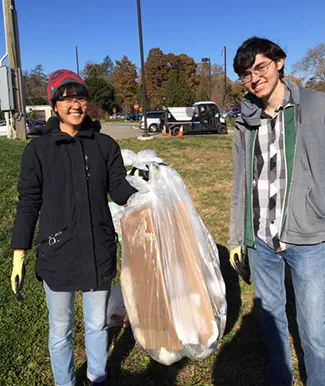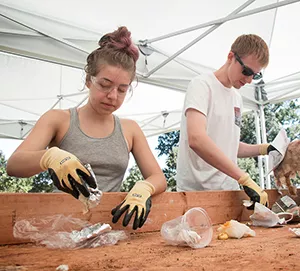The Quest for Zero Waste
You’d be hard-pressed to find a clearer mission statement than Zero Waste.
But achieving that — which, for starters, calls for diverting 80 percent of Swarthmore’s waste from a nearby incinerator by 2022 and affirming the College’s commitment to sustainability and the greater community — is complex.
Simply put, it takes College-wide buy-in.
Enter the Office of Sustainability, which has engaged and empowered all corners of campus for this decidedly on-the-ground effort.
“Waste involves choices people are making every single day,” says Aurora Winslade, director of sustainability. “It’s highly visible, and if we don’t do a good job with it, that’s highly visible, too.”
The key to the Zero Waste efforts, then, has been educating the College community on what can be recycled or composted, and raising awareness of what happens to our waste and the impacts it has on the greater community.
It’s reframing the way people think about waste, says Sacha Lin ’20, of Studio City, Calif., whose President’s Sustainability Research Fellowship (PSRF) project centers on Zero Waste.
“What I’ve enjoyed about this work,” Lin says, “is that it’s really about changing the way we live.”
Behind the Scenes
Right from the start, the Office of Sustainability saw Environmental Services (EVS) as a key partner in achieving Zero Waste. So it opened a dialogue, seeking staff members' perspectives on how to most easily and efficiently reduce the amount of waste sent to the incinerator.
Those conversations yielded improvements such as more convenient waste-bin liners as well as plant-based composting liners; color-coded consistency for all bins across campus; and a 40-yard-long container for recycling and a trash compactor at the Science Center, where EVS techs make sure that as many items as possible get recycled.

Sacha Lin '20 and Gabriel Brossy de Dios ‘20 sort waste, helping the College to analyze its practices.
Previously, EVS techs brought waste to dumpsters all across campus, which third-party trucks hauled away. There was no way to know what was in a given dumpster. If any of the recycling was deemed contaminated, it all went to the incinerator.
“We’re already at a point where 80 percent of our waste could be recycled or composted, but for us to actually get there, we need to keep centralizing efforts,” says Winslade, noting an ultimate goal of a single campus waste station. “Fewer trucks, less noise, cleaner streams.”
EVS techs have also assumed most of what had been students’ responsibility for collecting bags of compost from bins; they collect it on weekdays, while student Green Advisors (GAs) pick it up on weekends and sort it in daily shifts. But the most important element of the partnership with EVS may be how it positioned the more than 50 techs across campus as front-line ambassadors for Zero Waste.
“Our staff is very approachable and eager to help [community members] know what to do at the bins,” says Chip Proctor, manager of administration for EVS. “There’s a sense of pride in being a part of this moment of College history, and a sense of ownership taking hold.”
But further behind the scenes of this effort, beyond how waste is recycled and composted, lies a question: Where does trash go? The answer is the Covanta incinerator in nearby Chester, one of a cluster of waste facilities harming the health of residents of a low-income, predominantly Black community with little say in the matter.
“It’s important for us to illuminate that aspect — it’s real, and it’s right here,” says Melissa Tier ’14, sustainability program manager. “Our Zero Waste iniatitives alone won’t put an end to the incinerator, but we want our community to think seriously about the impacts of our waste, and to know that we have an alternative vision for doing it in a more sustainable and ethical way.”
The Life Cycle
Helping students realize their full intellectual and personal potential combined with a deep sense of ethical and social concern is at the heart of Swarthmore’s mission. Accordingly, students are the heart of Zero Waste.
Whether it’s analyzing the College’s waste practices, putting up signs and educating classmates on which waste goes where, or rooting their hands through piles of trash, Swarthmore students show passion for Zero Waste.
“There’s no way we could do this without them,” says Winslade, highlighting the GAs, PSRFs, and student Sustainability Committee members.
Lin and fellow PSRF Terrence Xiao ’20, of Beijing, China, continue to educate peers, staff, and faculty on optimum waste-sorting. Among recent additions are purple “I Don’t Know” bins at 101 South Chester Rd; people unsure of what to do with a piece of waste can just drop it in there, for GAs to collect and offer guidance on where it belongs.

The College aims to divert 80 percent of its waste from a nearby incinerator by 2022.
But the PSRFs will soon pivot from sorting to source — that is, reducing the amount of material the community uses once and then disposes. Compostable cups and straws and coffee lids are a big step forward, says Lin, “but nothing beats re-using.”
“It’s about rethinking our material flow, where we’re getting it from, and what we’re doing with it, to make it part of a cycle,” says Winslade.
And there’s a more figurative cycle at play. Because waste management can differ greatly from place to place, Swarthmore is eager for students to leave with a firm grasp of the core aspects.
“It’s understanding the issue well enough that wherever they go, they can ask the right questions and make good decisions,” says Winslade, pointing to Adina Spertus-Melhus ’17, who helped to jump-start Zero Waste as a PSRF in 2016 and now helps colleges and universities to reduce waste through the Post-Landfill Action Network.
Adds Christie Ashton, staff accountant of the Business Office and one of the staff members who supports Lin in her PSRF project: “Our students have an incredible ability to make a fearless difference in the world.”
For more news and event information, contact ZeroWaste@swarthmore.edu.



